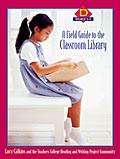[Notes from the session presented by Christine Robson from TCRWP]
- You can push kids' comprehension much further from book-to-book-to-book (Character work can become stronger once they know how the book tends to go)
- It can help foster the love for reading. We want readers to get hooked to the point where they can't put the book down
- Introduce books to create a buzz around books
- "If you love the Stink series, then you'll love the Judy Moody series"
- Partners who have a common text will be able to have a deeper conversation
- Build your series books in your library.
- Good source for book series: ebay as well as half.com
- Have a book drive in your school. There are kids in your school that might no longer need the old book series they have sitting around home
- Have a broad range of reading level (J/K/L/M)

2. Book Introductions
- As a small group, bring some of the kids together to do a special introduction. Some times kids need an intro before
- Ex: Magic Treehouse: If you don't read the first book, none of the other books will make sense.
- What are the complexities of this this text?
- Teachers College Field Guide can help (Noteworthy features, Characters, Structure, Writing about reading stuff, genre, etc.)
- You don't need to know every book in the series, but you need to know at least one book from the series very well
- How to do a Book Intro:
- Ex: Mystery Book Readers
- Step 1: Read the title and blurb...
- Step 2: Who? (detectives
- Ex: Possible Suspect/Theories (Kids at this level need to make more than one)
- Important for kids to have a plan (ex: Read the whole Cam Jansen series)

3. Support accumulating text, envisioning, inference, and synthesis
- Books will start to get a lot longer in chapter books.
- How is your chapter book organized? Is each chapter a new story? Think through together: What are the problems and solution from each chapter?
- Kids first have to think about their book: (Need to read the blurb)
- 5 short stories? Think about problem and solution from each chapter?
- Is it one problem across multiple chapters?
- Set it up:
- Read the blurb
- Read the chapter titles
- If there is one big problem, then there is one solution (Kids don't always realize that)
- How's it organized? Bunch of short stories with each one having a problem/solution, then at the end we think about how the problems and solutions are related? Or one big long story across the text? Have to be thinking from chapter-to-chapter-to-chapter about how they are trying to solve the problem and come to a solution.
4. Write about reading
- Way to start accumulating text:
- From the blurb: Record what is the most important in relation to the problem?
- Chapter 1: Most important thing that happened (in relation to the problem)?
- Chapter 2: Most important thing that happened (in relation to the problem)?
- Chapter 3: Most important thing that happened (in relation to the problem)?
- Chapter 4: Most important thing that happened (in relation to the problem)?
- Bare minimum as a chapter book reader: At LEAST one post-it in each chapter about the most important thing in relation to the problem
- She will model this during read aloud (She will have a bunch of post-its. Turn-and-talk, which post-it is the MOST important. [The one that is related to the problem/solution])
- Once kids are able to accumulate text, then they are ready to start doing some inferential work
- Pay attention to the action of the character. What does that make me think about them?
- Characters in this level often don't change. But kids can still think about how the character's FEELINGS changed. (Feelings changing are not the same as attributes changing)
- Don't accept only one answer. Push on their comprehension!
- They need multiple with evidence for each one
- Stop and jots on Post-its
- They need to be IDEAS (it is what the text does NOT say) If it said Poppleton like spaghetti, then it's not an idea.
- Character
- Relationships
- Lessons
5. Move partner work from conversation to collaboration

.JPG)

1 comment:
Thanks so much for taking these notes. They were so affirming to me. There is a change in second grade, adding the layers of many kinds of longer text into the reading workshop. Early chapter books is one kind. This is a nice scaffold model to use within the UOS. I really appreciate you taking the time to do this.
Starting to get excited about New York.
Post a Comment